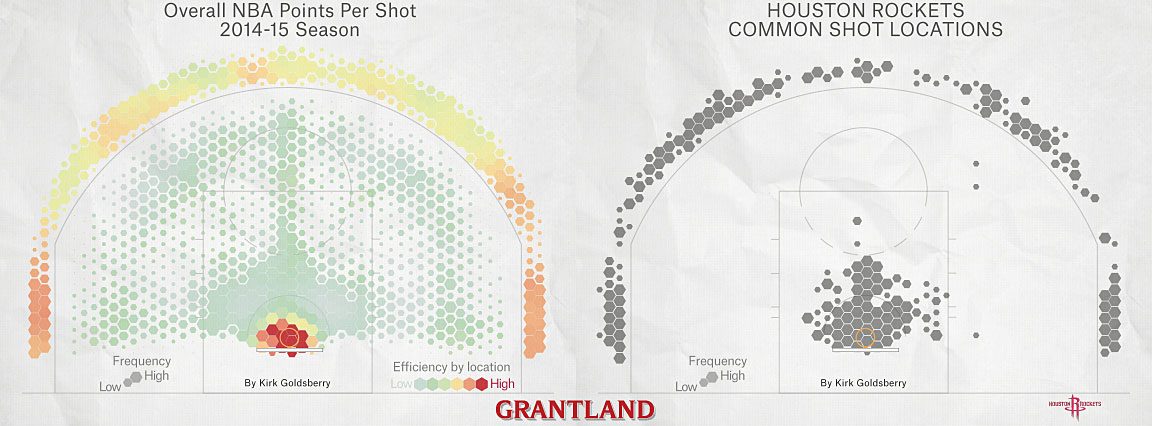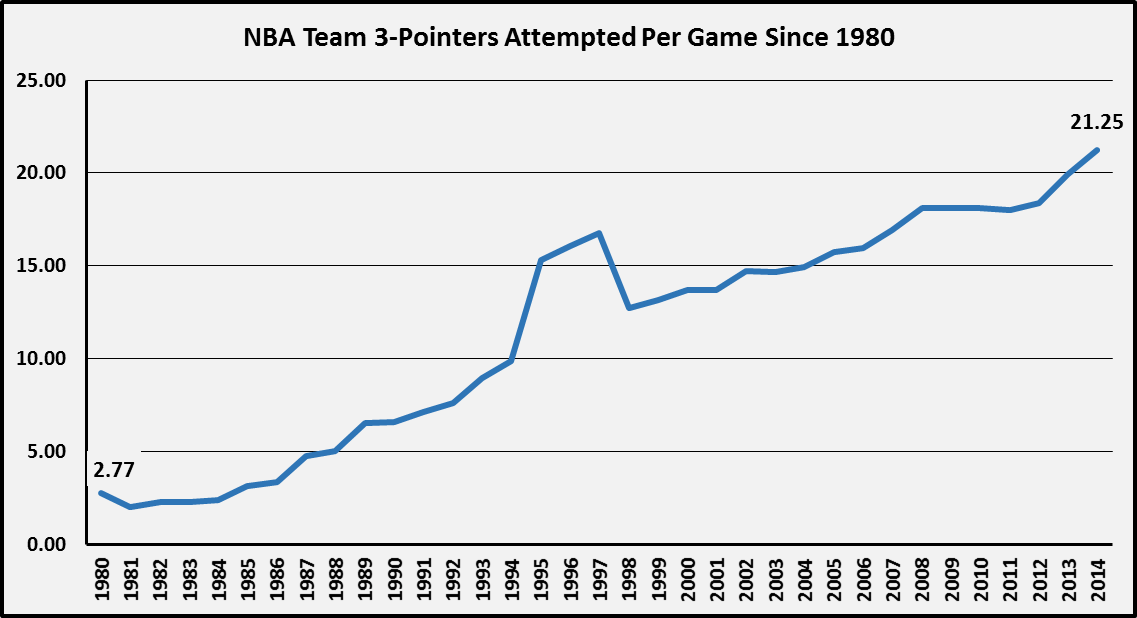Moreyball: The Houston Rockets and Analytics

How the Houston Rockets have taken basketball analytics to the next level and risen to the top of the NBA
Overview
As we saw in our case on TSG Hoffenheim, analytics can be used in various ways to improve a sports team’s performance on the field. While baseball was the first sport in the U.S. to fully internalize and adapt based on this realization, basketball has also begun to migrate toward more analytics-heavy strategies and techniques. The charge has been led by Daryl Morey, General Manager of the Houston Rockets, a former consultant and MIT Sloan Graduate who did not played professional or college basketball. His prior work as a statistical consultant drove him to gain a deeper understanding of basketball and how teams operate inefficiently, costing them wins.
Strategy
Morey’s most fundamental insight involved taking an increased number of three-point shots. Three-point shots in basketball are more difficult because they are further away from the basket, but Morey recognized that the 50% uplift in points received for the three-point shot (compared to a two-point shot) made it more mathematically efficient than almost all two-point shots other than dunks and lay-ups. In particular, Morey (and others) realized that three-point attempts from the corner of the court (“corner threes”) had a higher percentage chance of going in (because the shape of the three-point line made corner threes closer to the basket) and were therefore more valuable. Many set plays are now designed specifically to get strong three-point shooters open for corner threes. The on-court numbers back up the commitment to this strategy as the Rockets have already broken the record for most three-point shots made in a season, with games to spare. The team that previously held the record? None other than last season’s Rockets.
What Morey disliked on the court were longer two-point shots – these shots produced a lower average number of points per attempt. If a player was going to take a two point shot, Morey wanted them to be close to the basket inside the “restricted area”. The Rockets have taken 82% of their shots as either three-points shots or shots inside the restricted area this season; the second-highest team in that statistic is only at 71%. Morey’s team is more efficient with their shot selection and the results have shown: the Rockets currently lead the NBA in wins and rank second in points per game.
Risks
As the analytical methods have gained prominence over the past several years, other coaches and general managers have begun adopting a more statistics-based approach as well. The data backs this up – in the NBA overall last year, players shot a record number of three-point shots. The risks of the analytical-heavy decision-making processes are fairly limited but teams have had varying degrees of success. Without the right players to employ the analytics-heavy strategy, teams can easily fail to achieve the expected results. While three-point shots may be more efficient, if a team doesn’t possess any good three-point shooters, this strategy will still fail them. The trend of more three-point shots has also trickled down to college basketball; just in the past week, we saw Villanova set the record for most three-point shots made in a single Final Four game.
The NBA (and the Rockets in particular) has also received a fair amount of criticism for their style of play. Fans have degraded their approach as boring and repetitive as the team is frequently attempting similar types of shots on every possession. For the Rockets as an organization, they shouldn’t be worried about this criticism because as long as they are winning games, they will get fans in the seats. However, the NBA as a league might have some thinking to do regarding the changing style of play in their league. At the moment the NBA remains incredibly popular, but preventing the game from being a three-point shooting contest should be a relatively high priority for the league. One option is to move back the three-point line to make it more difficult and less efficient from a statistical perspective. However, there isn’t much room on the sides of the court to extend the three-point line; moreover, traditionalists don’t want these elements to change as it will make records and era comparisons incongruent.
Conclusion
Overall, what Daryl Morey has done is both highly innovative and successful. He saw an inefficient on the basketball court and won over the support of his organization by presenting the analytics justification for his methodology. The lingering question: how sustainable is this success?
See this YouTube clip for a 60 Minutes segment on basketball analytics: https://www.youtube.com/watch?v=BHuZc9lQ5ss
Exhibit 1: Shot efficiency in the NBA / Houston Rockets most common shot locations
Exhibit 2: League-wide three-point shots attempted over time
Sources:
https://inews.co.uk/sport/moreyball-houston-rockets-three-pointers/
https://qz.com/1104922/data-analytics-have-revolutionized-the-nba/
https://www.si.com/college-basketball/2018/03/31/villanova-3-point-records-final-four
The Future of Basketball Is Here, and It Looks a Lot Like James Harden
https://www.welcometoloudcity.com/2017/5/29/15707566/sounds-of-thunder-oklahoma-city-thunder-setting-their-sights-on-3-point-improvement





Thanks for writing about this Zach! As a huge NBA fan, I’ve been fascinated by Morey for a while now and his “hyper-efficient” brand of basketball. I think there are pretty meaningful benefits to this strategy that’s borne out in the data (and as you mention in your post). I do see risks with going so far with this strategy though, some of which are common pitfalls related to over-reliance on data. There could very well be a point at which only taking 3 point shots and shots inside the paint end up hurting offensively, as defenses adjust knowing that the Rockets will basically avoid all mid-range shots. Because analytics are done on past data related to historical defensive and offensive strategies, the resulting predictions will be most appropriate for those same playing styles – when playing styles change, the new “out of sample” data may no longer fit that trendline. Empirically (and we’ll have to see this year), the strategy hasn’t yielded the ultimate reward, which is an NBA championship. In fact, if you look at the Golden State Warriors this year, they are a hyper-efficient offense that actually rank in the top 10 of teams that take mid-range jump shots (what Morey would call the least efficient shots). It’ll be fascinating to see how this plays out in the playoffs.
Thank you for the post Zach. I think you pointed out something that is easily looked over with many of these big data strategies, which is they need to be effectively implemented. In the case of the Rockets, that means having James Harden and two other players that are in the top 25 in the league in true shooting %. More broadly, ensuring that learning from data analytics can be applied in context effectively is extremely important and where many of these promising application of data fall down.
Thanks for a great post! It is fascinating that teams are assigning value to the location of shots such as the restricted area and the corner three point shot. As you mentioned, if a team does not have great three point shooters, then this strategy will fail. I wonder if an analysis of each players most valuable shooting locations could create custom play creation to maximize the most efficient locations for each player.
Wow Zach – I really liked reading your post! You raise an interesting question about how sports might (or must) evolve in the 21st century, when you noted that NBA fans have criticized the Rockets for being boring. Sports may improve as teams or players use data analytics to optimize in-game decisions. But it also might strip the creativity out of sports. From a BSSE perspective, this might change the “job” or “set of experiences” that fans hire the professional sports league for (changing basketball from a creative, versatile and stylistic game… to one that is driven more by pure statistics and precision).
I think your conclusion is spot on: As players and teams optimize for sports, then sports need to consider modifications to their game rules — to reintroduce challenge and uncertainty. Another option the NBA could consider is eliminating the +1 free point chance for a fouled 3-point shot. I imagine with this recent change, the number of 3+1 free throws have also increased. Using the Rockets’ logic, the most efficient possible shot on the court is a fouled 3-point shot, which has a chance to score 4 points on one possession!
Thanks for the post! I love this! I wonder, what other substantial areas of focus have the Houston Rockets pursued in their data analytics centered approach? I remember reading a lot about this and the franchise in The Undoing Project book. They must be doing a lot since a) they’re doing very well as you said, b) all teams, fans and journalists have since adopted the 3-point math and hence the Rockets shouldn’t really have an edge anymore in that insight or execution.
Thanks!
Fascinating post, Zach! The movement of data analytics in sports has been an interesting one. As you alluded to, the importance of data in sports has led, in some cases, to a change in the profile of those who are running teams. For many years, teams were run by former players who deeply understood the game because they had participated in it for many years. More and more now, however, you’re seeing teams hiring managers who may have limited experience playing the sport but have deep experience in data analytics. Interestingly, a number of these more data-oriented managers are significantly younger. Take John Chayka, for example. He’s the GM of the Arizona Coyotes in the NHL. He became their GM at the age of 26, the youngest GM in the history of the big four North American sports. Before becoming GM of the Coyotes he was a member of the analytics company, Stathletes. Gives us non-former pro athletes hope of one day being able to run a team!